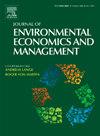Voting with their (left and right) feet: Are homebuyers’ values of neighborhood environmental amenities consistent with their politics?
IF 5.9
3区 经济学
Q1 BUSINESS
Journal of Environmental Economics and Management
Pub Date : 2025-03-28
DOI:10.1016/j.jeem.2025.103157
引用次数: 0
Abstract
There exists a consistent partisan gap in preferences for public spending on the environment, with approval being 20 to 40 percentage points higher for Democrats than Republicans. In this paper, we investigate whether there is a similar partisan gap present in residential preferences for environmental amenities. We link housing data, land use, and household characteristics, including voter registration, for three distinct housing markets, and we develop a residential sorting model to estimate marginal willingness-to-pay (MWTP) for residential proximity to conserved land, allowing for preference heterogeneity by partisanship as well as other household characteristics. For all households combined, we estimate average annual household MWTP for locations proximate to open space to range from $426 to $1061 across the three markets. In our model that allows for heterogeneous preferences across groups, we find no evidence that Republicans' MWTP is less than Democrats’ MWTP, and we statistically reject the magnitude of preference disparity found in voting studies. These findings establish a difference in relative preferences across venues that has implications for valuation research and political economy. To assess why relative preferences may differ across venues, we develop a simple theoretical model that applies to both housing and voting decisions and incorporates parameters for parochial altruism and tax aversion. Using prior estimates on partisan differences in key parameters, we find both intuitive and, to some extent, numerical support for the observed difference in relative preferences.
用(左脚和右脚)投票:购房者对社区环境便利设施的价值观是否与其政治立场一致?
在对公共环境支出的偏好上,两党之间一直存在分歧,民主党人的支持率比共和党人高出20到40个百分点。在本文中,我们调查是否有类似的党派差距存在于居住偏好的环境设施。我们将三个不同的住房市场的住房数据、土地使用和家庭特征(包括选民登记)联系起来,并开发了一个住宅分类模型来估计住宅靠近保护土地的边际支付意愿(MWTP),考虑到党派关系和其他家庭特征的偏好异质性。就所有家庭而言,我们估计在三个市场中,靠近开放空间位置的家庭平均年MWTP在426美元至1061美元之间。在我们的模型中,允许跨群体的异质性偏好,我们没有发现共和党人的MWTP低于民主党人的MWTP的证据,我们在统计上拒绝了投票研究中发现的偏好差异的程度。这些发现确定了不同地点之间相对偏好的差异,这对估值研究和政治经济学具有启示意义。为了评估为什么不同地点的相对偏好可能不同,我们开发了一个简单的理论模型,该模型适用于住房和投票决策,并纳入了教区利他主义和税收厌恶的参数。使用对关键参数的党派差异的先前估计,我们发现直观的和在某种程度上对观察到的相对偏好差异的数值支持。
本文章由计算机程序翻译,如有差异,请以英文原文为准。
求助全文
约1分钟内获得全文
求助全文
来源期刊
CiteScore
8.00
自引率
4.30%
发文量
91
期刊介绍:
The Journal of Environmental Economics and Management publishes theoretical and empirical papers devoted to specific natural resources and environmental issues. For consideration, papers should (1) contain a substantial element embodying the linkage between economic systems and environmental and natural resources systems or (2) be of substantial importance in understanding the management and/or social control of the economy in its relations with the natural environment. Although the general orientation of the journal is toward economics, interdisciplinary papers by researchers in other fields of interest to resource and environmental economists will be welcomed.

 求助内容:
求助内容: 应助结果提醒方式:
应助结果提醒方式:


